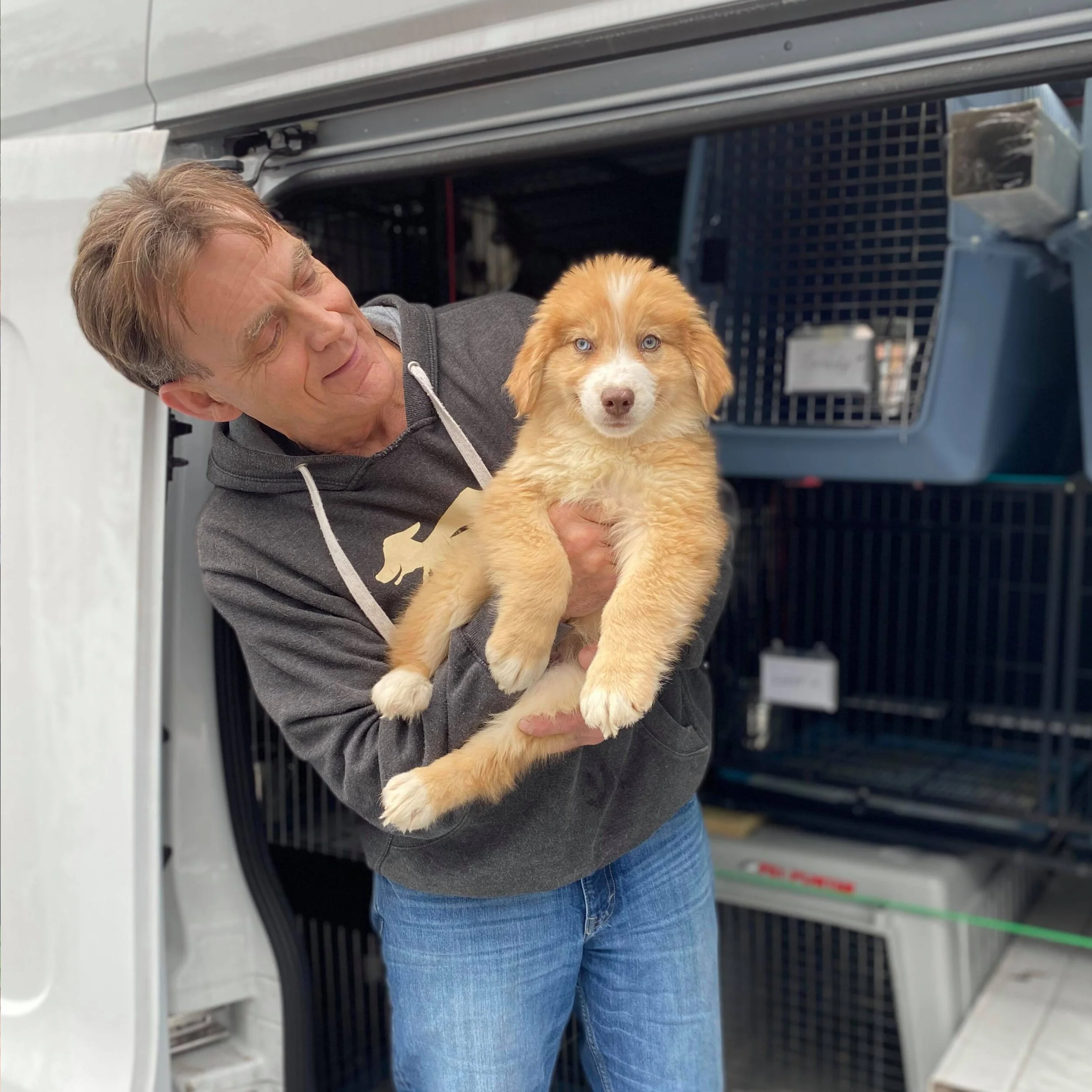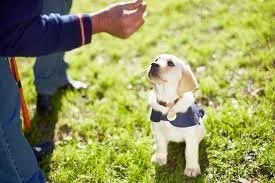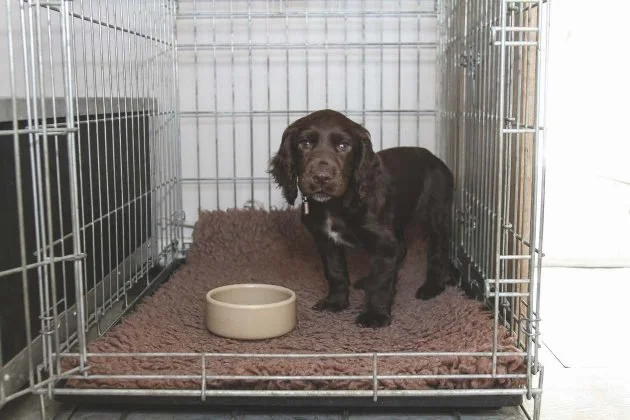Pet Blog > Puppy Training 101: Basic Puppy Training
Puppy Training 101: Basic Puppy Training
You did it. You finally brought home a brand new puppy. They’re so cute and you just want to hug them and squeeze them and love them all the time!
Good news– you’ll be spending a lot of time with your new puppy pal, but it won’t only be for cuddles. New puppies are a handful, and you’ll need to put in some work to help establish the rules in your home.
We know it’s hard to be tough because they’re so small and cute, but you don’t want a Marley & Me situation in your home. You don’t need to mold them into obedience show dog champs, but some basic commands and boundaries will work wonders for you and the dog.
When to Start Training
You’ll want to start as soon as possible. Puppies are cleared to come home at approximately 8 weeks of age. They are very susceptible to new cues and behaviors at this age, but they are also teeming with energy and easily distracted.
From birth to 16 weeks of age, your puppy is most susceptible to learning new behaviors, training, and socialization. Subject your dog to many new experiences and stimuli during this time. Regularly invite family and friends to visit with your puppy so they become acquainted with humans being around. Get them acquainted with the sights, sounds, and smells associated with people, and signal to them that it’s okay.
Dogs that are not trained or subjected to new experiences during the critical period are less susceptible to adapt later on, and it could mean you must overcome challenges to get them up to speed. Don’t stress– you can absolutely work with an older puppy or even an adult dog. Contrary to the adage, old dogs can learn new tricks!
How to Train
Keep training sessions short and conduct the training in a quiet, distraction-free environment. A few brief minutes is more than adequate to run through a few commands, reward and praise your puppy, and let them resume playtime.
You can scale the difficulty as your puppy shows progress, but start small and work your way up over time. Small victories build your puppy’s confidence and keep the training engaging and effective. Be generous with your praise, and the treats too!
Use Treats
Puppies are so busy getting into everything, it’s hard to get them to stop and pay attention!
The most common way to keep them locked in on you is through the use of a motivator– treats! Show your puppy the treat and call their attention to it. If they lose interest or get distracted, try waving the treat in front of their nose to get their attention back. Remember– dogs rely on their noses often, so a whiff of a delicious treat should get them back reliably.
We recommend including at least two types of treats during training including a standard treat and a high-value treat. The high-value treat should be something they really like to signal that what they’ve done is a very good job. You may also provide a high-value treat occasionally during the training to keep them on their toes. They’ll be more apt to pay attention if they think another tasty one is coming their way any moment now!
Treats should be tasty and bite-sized. You’ll waste time and lose their focus if the treat requires the dog to sit down or chew a lot. Select bite-sized cookies, meat treats, jerky bits, or even human food in small quantities.
Gradually Increase the 3 Ds
Don’t discount the 3 Ds of dog training as you progress. They are distance, duration, and distraction.
Distance
It’s fine that you asked them to sit while you’re standing right there, but what if you walk a few steps away? Do they hold the command, or break it to follow you?
Distance refers to how far you can get from your dog while they maintain the command. You’ll need to build gradually, as asking them to sit and then walking completely away will only set them up for failure. Increase the distance slowly until they can hold the command from an adequate distance.
Duration
Maybe you’ve worked to a place where your precious pup can sit still for a few seconds. That’s excellent and it should be rewarded! Over time, you’ll want to gradually increase the amount of time they can hold that sit.
Be sure not to reward them if they’ve broken out of the command. The trick is to praise and reward them while they are still holding the command, or they may not make the association.
Distraction
Dogs will need to learn how to hold the commands in distracting environments to truly demonstrate mastery. A dog that responds to your recall command is great if you’re home alone, but useless and possibly dangerous if they completely ignore you out in the world.
Start out working in a completely distraction-free environment, then ask a friend or family member to be present during training. Ask them to do something intriguing like digging in a crinkly bag or squeaking a toy off to the side. It will be tempting for your pup, but holding the command and staying obedient to you is the ultimate goal.
Training takes time and patience. Be sure to reward the little wins, stay positive, and scale gradually for your best chances of success.
What to Train
You don’t necessarily need a show dog that can sit beside the Thanksgiving dinner table in a sit-stay and never budge, although some people prefer that and there’s nothing wrong with it. At minimum, we recommend they learn the following:
Housebreaking
Sit
Stay
Recall
Sure, roll over and speak are fun party tricks to show off how smart your dog is, but they may not be useful in situations where you need them to behave appropriately or keep out of danger.
Housebreaking
Arguably the most important skill to teach your puppy is housebreaking. Most dog owners accomplish this through the use of crate training. Crates make use of the puppy’s natural instinct to refrain from peeing where they sleep.
A properly sized crate will allow the dog only enough room to stand, lay, and turn around. Wire crates with adjustable dividers that can be moved to accommodate growing puppies are recommended. Be sure to purchase one that is large enough to accommodate their expected adult size, but make use of that divider for all the various in-between sizes along the way.
Puppies should be crated overnight and when you are out of the house. At first, they will only be able to hold their bladder for 2-3 hours and require being let out regularly. Let your puppy outside immediately after opening the crate and encourage them to do their business. Use whatever phrase you wish to associate with the act to signal what you’d like for them to do.
Once they go, give your puppy praise and a treat, but be careful with the timing. If you’re too quick, they may stop going potty before they’re done and you’ll wind up starting the process all over again.
Sit
Busy puppies will have a hard time with sitting at first since they are always on the move. Command their attention using a treat. Bring it from their nose to over their head. Most dogs naturally will move their butts to the ground as they look up, at which point you should provide the treat and praise.
If your dog really is not getting the sit movement, it’s okay to guide them gently. After a few assists, they learn that their butt being on the floor was what got them the treat and they will start doing it on their own.
Stay
Stay can be tricky. If the dog thinks you are leaving, they will pop up to follow. Use a leash to keep them from following, but remember to scale distance gradually. At first, a stay from only two or three steps away is good enough.
When teaching stay, you’ll want to have a word associated with breaking the stay like “okay.” This lets them know when they should be free to go about their business once more and take the treat.
Recall
Recall refers to their ability to come back to you when beckoned, and most of us know firsthand that this is easier said than done.
We recommend working on recall after sit and stay are mastered to some degree. From a stay, issue the command that signals they may break the stay, and naturally, your dog will come running to claim their reward.
As they approach, use their name and praise them for coming to you. Over time, they will associate their name with good things like treats and praise and will be eager to approach when beckoned.
Unfortunately, this means using their name for other purposes will hurt the effort to build a good recall. Using their name during discipline will especially hurt the effort. We know that it’s hard not to default to using their name when you find that they got into the garbage, but we must do our best to only use their name when calling them over. It must have strictly positive implications for it to be successful.
Training as a Lifestyle
While you’ll do most of the training in your puppy’s formative weeks, training is a lifelong endeavor. The adage that “an old dog can’t learn new tricks” is inaccurate, and you can engage them and work on new behaviors at any point during their lives. Doing so is a great step toward keeping them physically and mentally engaged so that they live their best lives.
By mastering some of the most simple behaviors and obedience commands, you will enjoy a more stress-free puppy experience. Then you can focus on other things like what kind of toys they like best or the best food for your lab puppy.
Lay the foundation in their formative weeks, and you’ll guarantee that you and your dog enjoy your best lives together.
Brad Clarke is someone who cannot remember life without dogs around, he simply can’t live without them! He created Dog Nerdz to provide owners with crucial tips and essential info in order to be the best dog owner they can be. He has learned so much over the years about how to look after his precious pup Boogie!
Check out our other Dog Blog articles
Return to the Pet Blog




